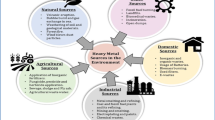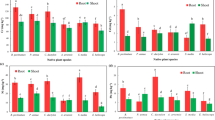Abstract
The retention of heavy metal (HM) was studied in root and rhizomes (BLG), stems (ST), and leaves (LF) of Phragmites australis (common reed) seedlings collected from different locations, differing in the scale of anthropogenic interference. The analysis includes the reference samples of sediments in uncontaminated lake Garczonki and contaminated roadside ditch in Cieplewo. The concentrations of Zn, Cu, Pb, Cd, Ni, and Cr were analyzed in plant tissues and sediments using the atomic absorption spectrometry and inductively coupled plasma mass spectrometry. The general assessment of sediments collected in the Garczonki lake showed a good environmental status; while in the roadside ditch in Cieplewo, the sediments were considerably polluted with HM. In the first stage of plant growth, all of the analyzed HMs are mainly inhibited by BLG system. The decreasing trend of elements was as follows: BLG > ST > LF. The organs followed different decreasing trends of HM concentration; the trend Zn > Cu > Ni > Cr > Pb > Cd was found in ST and LF for the Garczonki lake seedlings and for BLG and LF for the roadside ditch in Cieplewo seedlings. Zn showed the highest concentration, while Cd the lowest concentration in each of the examined organs. The bioaccumulation factor indicated the higher mobility of HM in seedlings in the Garczonki lake than in the roadside ditch in Cieplewo. The morphological studies suggest the good state and health of seedling from both sites; however, the reduction of root hair surface was observed for the roadside ditch seedlings. The anatomical studies present changes in the size of the nucleus and count of chloroplasts in LF. No reaction on HM contamination sediments in the seedlings from the roadside ditch in Cieplewo in the aerenchyma was noted. Potentially, both types of seedlings can be used to decontaminate environments rich in HM. However, the level of HM absorbed by seedlings (in the first stage of growth) should be considered due to the behavior in the target phytoremediation site.

Similar content being viewed by others
References
Acosta JA, Gabarrón M, Faz A, Martínez-Martínez S, Zornoza R, Arocena JM (2015) Influence of population density on the concentration and speciation of metals in the soil and street dust from urban areas. Chemosphere 134:328–337. https://doi.org/10.1016/j.chemosphere.2015.04.038
Adamiec E, Jarosz-Krzemińska E, Wieszała R (2016) Heavy metals from non-exhaust vehicle emissions in urban and motorway road dusts. Environ Monit Assess 188(6):369. https://doi.org/10.1007/s10661-016-5377-1
Alahabadi, A., & Malvandi, H. (2018). Contamination and ecological risk assessment of heavy metals and metalloids in surface sediments of the Tajan River , Iran. Mar Pollut Bull, 133(June), 741–749. https://doi.org/10.1016/j.marpolbul.2018.06.030
Ali H, Khan E, Sajad MA (2013) Phytoremediation of heavy metals-concepts and applications. Chemosphere 91(7):869–881. https://doi.org/10.1016/j.chemosphere.2013.01.075
Ashraf MA, Maah MJ, Yusoff I (2011) Heavy metals accumulation in plants growing in ex tin mining catchment. Int J Environ Sci Technol 8(2):401–416. https://doi.org/10.1007/BF03326227
Bonanno G (2011) Trace element accumulation and distribution in the organs of Phragmites australis (common reed) and biomonitoring applications. Ecotoxicol Environ Saf 74(4):1057–1064. https://doi.org/10.1016/j.ecoenv.2011.01.018
Bonanno G, Lo Giudice R (2010) Heavy metal bioaccumulation by the organs of Phragmites australis (common reed) and their potential use as contamination indicators. Ecol Indic 10(3):639–645. https://doi.org/10.1016/j.ecolind.2009.11.002
Bonanno G, Vymazal J (2017) Compartmentalization of potentially hazardous elements in macrophytes: insights into capacity and efficiency of accumulation. J Geochem Explor 181(May):22–30. https://doi.org/10.1016/j.gexplo.2017.06.018
Bragato C, Brix H, & Malagoli M (2006) Accumulation of nutrients and heavy metals in Phragmites australis (Cav.) Trin. ex Steudel and Bolboschoenus maritimus (L.) Palla in a constructed wetland of the Venice lagoon watershed. Environ Pollut, 144(3), 967–975. https://doi.org/10.1016/j.envpol.2006.01.046
Chabukdhara M, Nema AK (2013) Heavy metals assessment in urban soil around industrial clusters in Ghaziabad, India: probabilistic health risk approach. Ecotoxicol Environ Saf 87:57–64. https://doi.org/10.1016/j.ecoenv.2012.08.032
Cristaldi A, Conti GO, Jho EH, Zuccarello P, Grasso A, Copat C, Ferrante M (2017) Phytoremediation of contaminated soils by heavy metals and PAHs. A brief review. Environ Technol Innov 8:309–326. https://doi.org/10.1016/j.eti.2017.08.002
Divan AM, de Oliveira PL, Perry CT, Atz VL, Azzarini-Rostirola LN, Raya-Rodriguez MT (2009) Using wild plant species as indicators for the accumulation of emissions from a thermal power plant, Candiota, South Brazil. Ecol Indic 9(6):1156–1162. https://doi.org/10.1016/j.ecolind.2009.01.004
Ederli L, Reale L, Ferranti F, Pasqualini S (2004) Responses induced by high concentration of cadmium in Phragmites australis roots. Physiol Plant 121(1):66–74. https://doi.org/10.1111/j.0031-9317.2004.00295.x
Elshamy MM, Heikal YM, Bonanomi G (2019) Phytoremediation efficiency of Portulaca oleracea L. naturally growing in some industrial sites, Dakahlia District, Egypt. Chemosphere 225:678–687. https://doi.org/10.1016/j.chemosphere.2019.03.099
Hakanson L (1980) An ecological risk index for aquatic pollution control.a sedimentological approach. Water Res 14 (8):975-1001. https://doi.org/10.1016/0043-1354(80)90143-8
Hinchman RR, Negri MC, Gatliff EG (1995) Phytoremediation: using green plants to clean up contaminated soil, groundwater, and wastewater ray. Applied Natural Sciences, Inc
Hu Y, Wang D, Wei L, Zhang X, Song B (2014) Bioaccumulation of heavy metals in plant leaves from Yan[U+05F3]an city of the loess plateau, China. Ecotoxicol Environ Saf 110:82–88. https://doi.org/10.1016/j.ecoenv.2014.08.021
Huerta Buitrago B, Ferrer Muñoz P, Ribé V, Larsson M, Engwall M, Wojciechowska E, Waara S (2013) Hazard assessment of sediments from a wetland system for treatment of landfill leachate using bioassays. Ecotoxicol Environ Saf, 97, 255–262. https://doi.org/10.1016/j.ecoenv.2013.08.010
Islam S, Ahmed K, Habibullah-Al-Mamun M, Masunaga S (2015) Potential ecological risk of hazardous elements in different land-use urban soils of Bangladesh. Sci Total Environ 512–513:94–102. https://doi.org/10.1016/j.scitotenv.2014.12.100
Kabata-Pendias A, Pendias H (2001) Biogeochemistry of trace elements. Trace elements in soils and plants, fourth edition (Vol. 2nd), chapter 5 (trace elements in plants) https://doi.org/10.1201/b10158-25
Kulbat E, Sokołowska A (2019) Methods of Assessment of Metal Contamination in Bottom Sediments (Case Study: Straszyn Lake, Poland). Arch Environ Con Tox 77 (4):605-618
Kumar Yadav K, Gupta N, Kumar A, Reece LM, Singh N, Rezania S, Ahmad Khan S (2018) Mechanistic understanding and holistic approach of phytoremediation: a review on application and future prospects. Ecol Eng 120(June):274–298. https://doi.org/10.1016/j.ecoleng.2018.05.039
Lee B, Scholz M (2006) What is the role of Phragmites australis in experimental constructed wetland filters treating urban runoff ? 9:87–95. https://doi.org/10.1016/j.ecoleng.2006.08.001
Likuku, A. S., Mmolawa, K. B., & Gaboutloeloe, G. K. (2013). Assessment of heavy metal enrichment and degree of con- tamination around the copper-nickel mine in the Selebi Phikwe region, Eastern Botswana. Environment and Ecology Research, 1(2), 32–40. https://doi.org/10.13189/eer.2013.010202
Liu L, Li W, Song W, Guo M (2018) Remediation techniques for heavy metal-contaminated soils: Principles and applicability. Sci Total Environ 633:206-219. https://doi.org/10.1016/j.scitotenv.2018.03.161
Minkina T, Fedorenko G, Nevidomskaya D, Fedorenko A, Chaplygin V, Mandzhieva S (2018) Morphological and anatomical changes of Phragmites australis Cav. due to the uptake and accumulation of heavy metals from polluted soils. Sci Total Environ 636:392–401. https://doi.org/10.1016/j.scitotenv.2018.04.306
Minkina T, Fedorenko G, Nevidomskaya D, Pol’shina T, Federenko A, Chaplygin V et al (2019) Bioindication of soil pollution in the delta of the Don River and the coast of the Taganrog Bay with heavy metals based on anatomical , morphological and biogeochemical studies of macrophyte ( Typha australis Schum . & Thonn ). Environ Geochem Health 3. https://doi.org/10.1007/s10653-019-00379-3
Obarska-Pempkowiak H, Haustein E, Wojciechowska E (2005) Distribution of heavy metals in vegetation of constructed wetlands in agricultural catchment. Chapter in book
Obarska-Pempkowiak H, Gajewska M, Wojciechowska E, Pempkowiak J (2015) Treatment wetlands for environmental pollution control (GeoPlanet). Springer. https://doi.org/10.1007/978-3-319-13794-0
Prasad M (2003) Phytoremediation of metal-polluted ecosystems : hype for commercialization *. Russ J Plant Physiol 50(5):686–700. https://doi.org/10.1023/A:1025604627496
Rout G, Das P (2003) Effect of metal toxicity on plant growth and metabolism, review article Effect of metal toxicity on plant growth and metabolism : I . Zinc. https://doi.org/10.1051/agro
Rucin, R. (2016). Water relations in plants subjected to heavy metal stresses ´. https://doi.org/10.1007/s11738-016-2277-5
Sałata A, Dąbek L (2017) Methods of assessment of stormwater sediments quality. E3S Web of Conferences 17(June):00080. https://doi.org/10.1051/e3sconf/20171700080
Sarwar N, Rehim A, Kamran MA, Shaheen MR, Matloob A, Imran M et al (2016) Phytoremediation strategies for soils contaminated with heavy metals: modifications and future perspectives. Chemosphere 171:710–721. https://doi.org/10.1016/j.chemosphere.2016.12.116
Sekabira K, Origa HO, Basamba TA, Mutumba G, Kakudidi E (2010) Assessment of heavy metal pollution in the urban stream sediments and its tributaries. Int J Environ Sci Technol 7(3):435–446. https://doi.org/10.1007/BF03326153
Sheoran V, Sheoran AS, Poonia P (2011) Role of hyperaccumulators in phytoextraction of metals from contaminated mining sites: a review. Crit Rev Environ Sci Technol 41(2):168–214
Southichak B, Nakano K, Nomura M, Chiba N, Nishimura O (2006) Phragmites australis: a novel biosorbent for the removal of heavy metals from aqueous solution. Water Res 40(12):2295–2302. https://doi.org/10.1016/j.watres.2006.04.027
Sridhar B B M, Diehl S V, Han F X, Monts D L, Su Y (2005) Anatomical changes due to uptake and accumulation of Zn and Cd in Indian mustard (Brassica juncea). Environ Exp Bot 54 (2):131-141. https://doi.org/10.1016/j.envexpbot.2004.06.011
Thomas M, Dudley W (1894) A laboratory manual of plant histology. Crawfordsville, Indiana, pg.16–24
Tomlinson D L, Wilson J G, Harris C R, Jeffrey D W (2013) Assessment of Heavy Metal Enrichment and Degree of Contamination Around the Copper-Nickel Mine in the Selebi Phikwe Region, Eastern Botswana. Environ Ecol Res, 1(2), 32–40. https://doi.org/10.13189/eer.2013.010202
Vymazal J (2016) Concentration is not enough to evaluate accumulation of heavy metals and nutrients in plants. Sci Total Environ 544:495-498
Vymazal J, Březinová T (2016) Accumulation of heavy metals in aboveground biomass of Phragmites australis in horizontal flow constructed wetlands for wastewater treatment: a review. Chem Eng J 290:232–242. https://doi.org/10.1016/j.cej.2015.12.108
Vymazal J, Švehla J, Kröpfelová L, Chrastný V (2007) Trace metals in Phragmites australis and Phalaris arundinacea growing in constructed and natural wetlands. Sci Total Environ 380(1–3):154–162. https://doi.org/10.1016/j.scitotenv.2007.01.057
Wang G, Liu HQ, Gong Y, Wei Y, Miao AJ, Yang LY, Zhong H (2017) Risk assessment of metals in urban soils from a typical industrial city, Suzhou, Eastern China. Int J Environ Res Public Health 14(9). https://doi.org/10.3390/ijerph14091025
Wojciechowska E, Waara S (2011) Distribution and removal efficiency of heavy metals in two constructed wetlands treating landfill leachate. Water Sci Technol 64(8):1597–1606. https://doi.org/10.2166/wst.2011.680
Wojciechowska E, Nawrot N, Walkusz-Miotk J, Matej-Łukowicz K, Pazdro K (2019) Heavy metals in sediments of urban streams : contamination and health risk assessment of influencing factors. 11:563. https://doi.org/10.3390/su11030563
Wojciechowska E, Obarska-Pempkowiak H (2008) Performance of Reed Beds Supplied with Municipal Landfill Leachate. In: Vymazal J. (eds) Wastewater Treatment, Plant Dynamics and Management in Constructed and Natural Wetlands. Springer, Dordrecht
Yang J, Zheng G, Yang J, Wan X, Song B, Cai W, Guo J (2017) Phytoaccumulation of heavy metals (Pb, Zn, and Cd) by 10 wetland plant species under different hydrological regimes. Ecol Eng 107:56–64. https://doi.org/10.1016/j.ecoleng.2017.06.052
Zuo S, Dai S, Li Y, Tang J, Ren Y (2018) Analysis of heavy metal sources in the soil of riverbanks across an urbanization gradient. https://doi.org/10.3390/ijerph15102175
Funding
The work was completed under a GRAM grant, awarded in a competitive procedure by the Dean of the Faculty of Civil and Environmental Engineering, Gdansk University of Technology. The grants are funded from science funds as specified in the Journal of Laws no. 96, item 615, as amended. The authors acknowledge the support provided by InterPhD2 program funded by the European union (Project No. POWR.03.02.00-IP.08–00-DOK/16).
Author information
Authors and Affiliations
Corresponding author
Additional information
Responsible editor: Elena Maestri
Publisher’s note
Springer Nature remains neutral with regard to jurisdictional claims in published maps and institutional affiliations.
Electronic supplementary material
ESM 1
(DOCX 631 kb)
Rights and permissions
About this article
Cite this article
Nawrot, N., Wojciechowska, E., Matej-Łukowicz, K. et al. Heavy metal accumulation and distribution in Phragmites australis seedlings tissues originating from natural and urban catchment. Environ Sci Pollut Res 28, 14299–14309 (2021). https://doi.org/10.1007/s11356-019-07343-9
Received:
Accepted:
Published:
Issue Date:
DOI: https://doi.org/10.1007/s11356-019-07343-9




